Performance Management and Reward System in Volkswagen: A Report
VerifiedAdded on 2020/06/04
|10
|2621
|68
Report
AI Summary
This report delves into the performance management system of Volkswagen, examining its policies, procedures, and effectiveness. It explores how Volkswagen evaluates employee performance, focusing on the implementation of various theories like Locke's Goal-setting theory and Vroom's Expectancy theory. The report critically evaluates the degree to which performance management policies demonstrate skills and rewards, analyzing the benefits such as performance-based conversations, targeted staff development, and the identification of underperformers. It also addresses potential issues like time consumption, discouragement, and biases. The analysis includes a discussion of the performance management cycle, emphasizing the importance of planning, monitoring, and evaluation. The report concludes with recommendations for improvement, aiming to enhance employee productivity, foster a positive work environment, and achieve organizational goals. The report also discusses the benefits and issues of organization performance management and suggests how to improve it for the future.
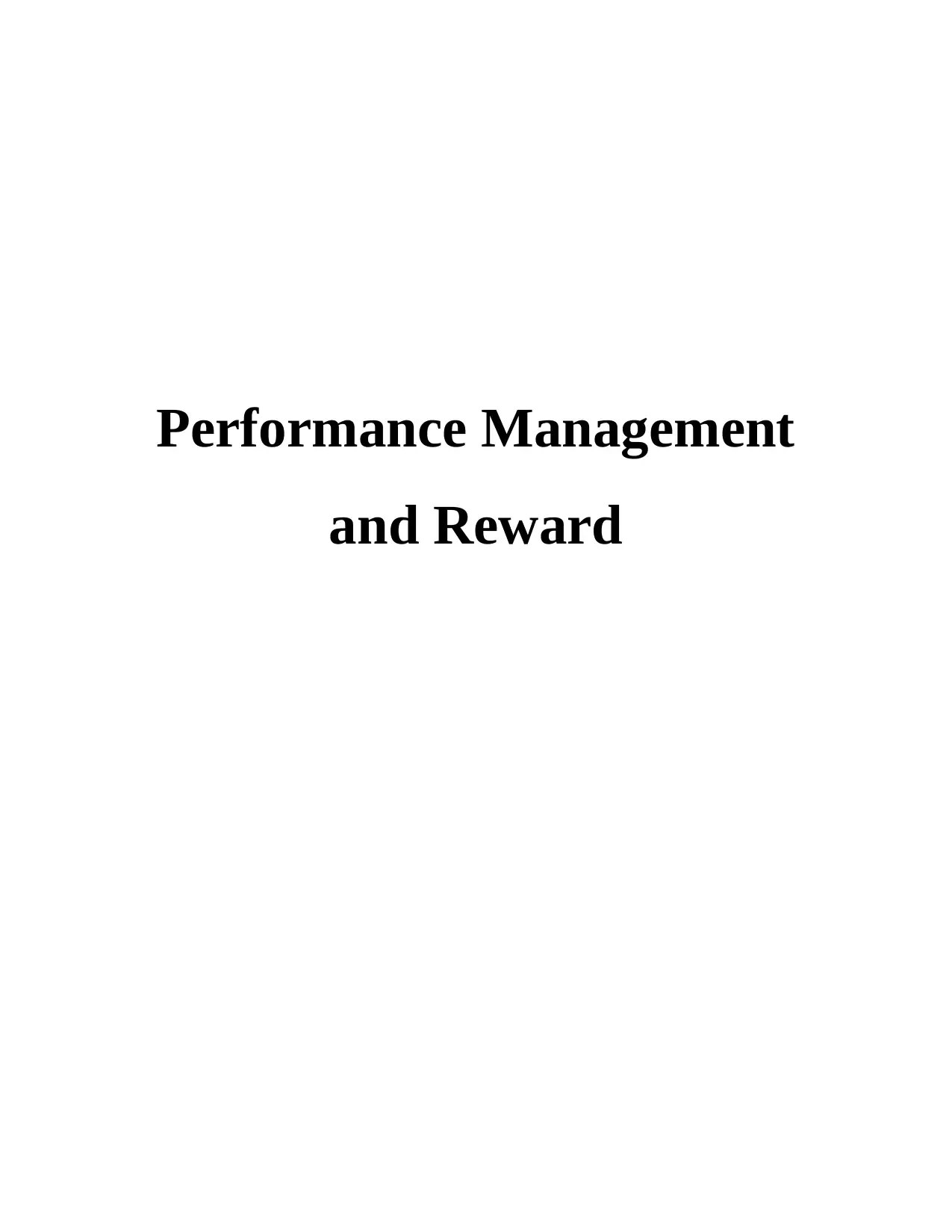
Performance Management
and Reward
and Reward
Paraphrase This Document
Need a fresh take? Get an instant paraphrase of this document with our AI Paraphraser
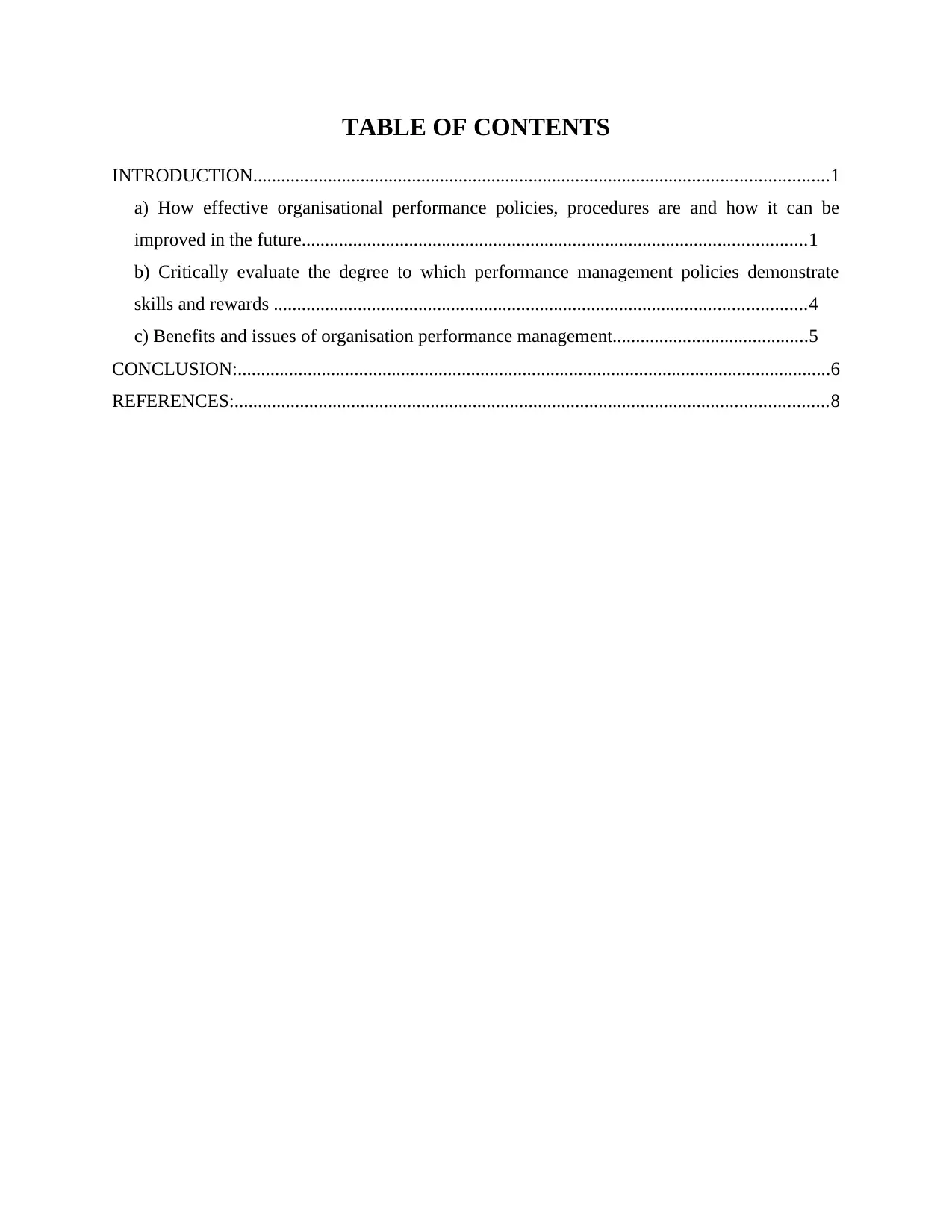
TABLE OF CONTENTS
INTRODUCTION...........................................................................................................................1
a) How effective organisational performance policies, procedures are and how it can be
improved in the future............................................................................................................1
b) Critically evaluate the degree to which performance management policies demonstrate
skills and rewards ..................................................................................................................4
c) Benefits and issues of organisation performance management..........................................5
CONCLUSION:...............................................................................................................................6
REFERENCES:...............................................................................................................................8
INTRODUCTION...........................................................................................................................1
a) How effective organisational performance policies, procedures are and how it can be
improved in the future............................................................................................................1
b) Critically evaluate the degree to which performance management policies demonstrate
skills and rewards ..................................................................................................................4
c) Benefits and issues of organisation performance management..........................................5
CONCLUSION:...............................................................................................................................6
REFERENCES:...............................................................................................................................8
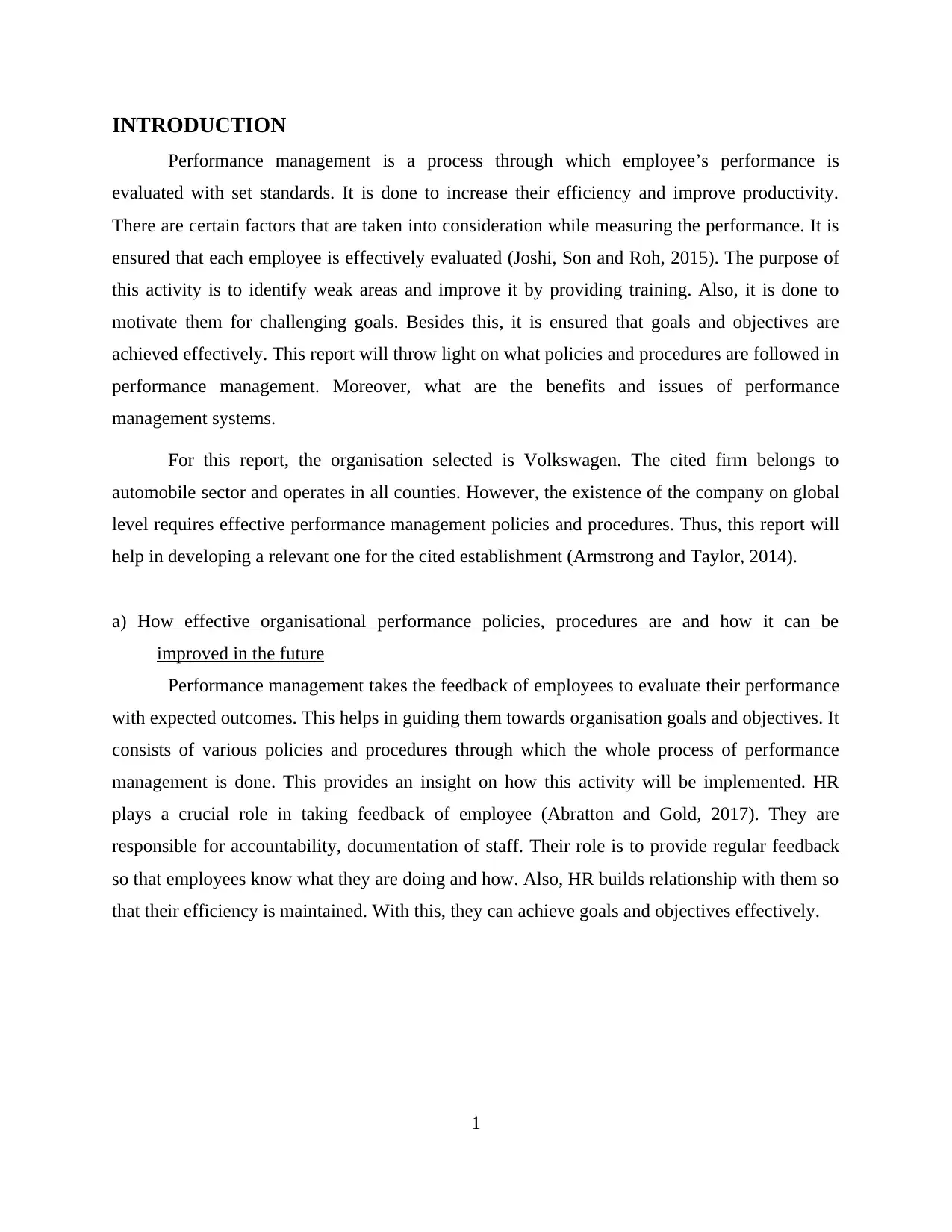
INTRODUCTION
Performance management is a process through which employee’s performance is
evaluated with set standards. It is done to increase their efficiency and improve productivity.
There are certain factors that are taken into consideration while measuring the performance. It is
ensured that each employee is effectively evaluated (Joshi, Son and Roh, 2015). The purpose of
this activity is to identify weak areas and improve it by providing training. Also, it is done to
motivate them for challenging goals. Besides this, it is ensured that goals and objectives are
achieved effectively. This report will throw light on what policies and procedures are followed in
performance management. Moreover, what are the benefits and issues of performance
management systems.
For this report, the organisation selected is Volkswagen. The cited firm belongs to
automobile sector and operates in all counties. However, the existence of the company on global
level requires effective performance management policies and procedures. Thus, this report will
help in developing a relevant one for the cited establishment (Armstrong and Taylor, 2014).
a) How effective organisational performance policies, procedures are and how it can be
improved in the future
Performance management takes the feedback of employees to evaluate their performance
with expected outcomes. This helps in guiding them towards organisation goals and objectives. It
consists of various policies and procedures through which the whole process of performance
management is done. This provides an insight on how this activity will be implemented. HR
plays a crucial role in taking feedback of employee (Abratton and Gold, 2017). They are
responsible for accountability, documentation of staff. Their role is to provide regular feedback
so that employees know what they are doing and how. Also, HR builds relationship with them so
that their efficiency is maintained. With this, they can achieve goals and objectives effectively.
1
Performance management is a process through which employee’s performance is
evaluated with set standards. It is done to increase their efficiency and improve productivity.
There are certain factors that are taken into consideration while measuring the performance. It is
ensured that each employee is effectively evaluated (Joshi, Son and Roh, 2015). The purpose of
this activity is to identify weak areas and improve it by providing training. Also, it is done to
motivate them for challenging goals. Besides this, it is ensured that goals and objectives are
achieved effectively. This report will throw light on what policies and procedures are followed in
performance management. Moreover, what are the benefits and issues of performance
management systems.
For this report, the organisation selected is Volkswagen. The cited firm belongs to
automobile sector and operates in all counties. However, the existence of the company on global
level requires effective performance management policies and procedures. Thus, this report will
help in developing a relevant one for the cited establishment (Armstrong and Taylor, 2014).
a) How effective organisational performance policies, procedures are and how it can be
improved in the future
Performance management takes the feedback of employees to evaluate their performance
with expected outcomes. This helps in guiding them towards organisation goals and objectives. It
consists of various policies and procedures through which the whole process of performance
management is done. This provides an insight on how this activity will be implemented. HR
plays a crucial role in taking feedback of employee (Abratton and Gold, 2017). They are
responsible for accountability, documentation of staff. Their role is to provide regular feedback
so that employees know what they are doing and how. Also, HR builds relationship with them so
that their efficiency is maintained. With this, they can achieve goals and objectives effectively.
1
⊘ This is a preview!⊘
Do you want full access?
Subscribe today to unlock all pages.

Trusted by 1+ million students worldwide
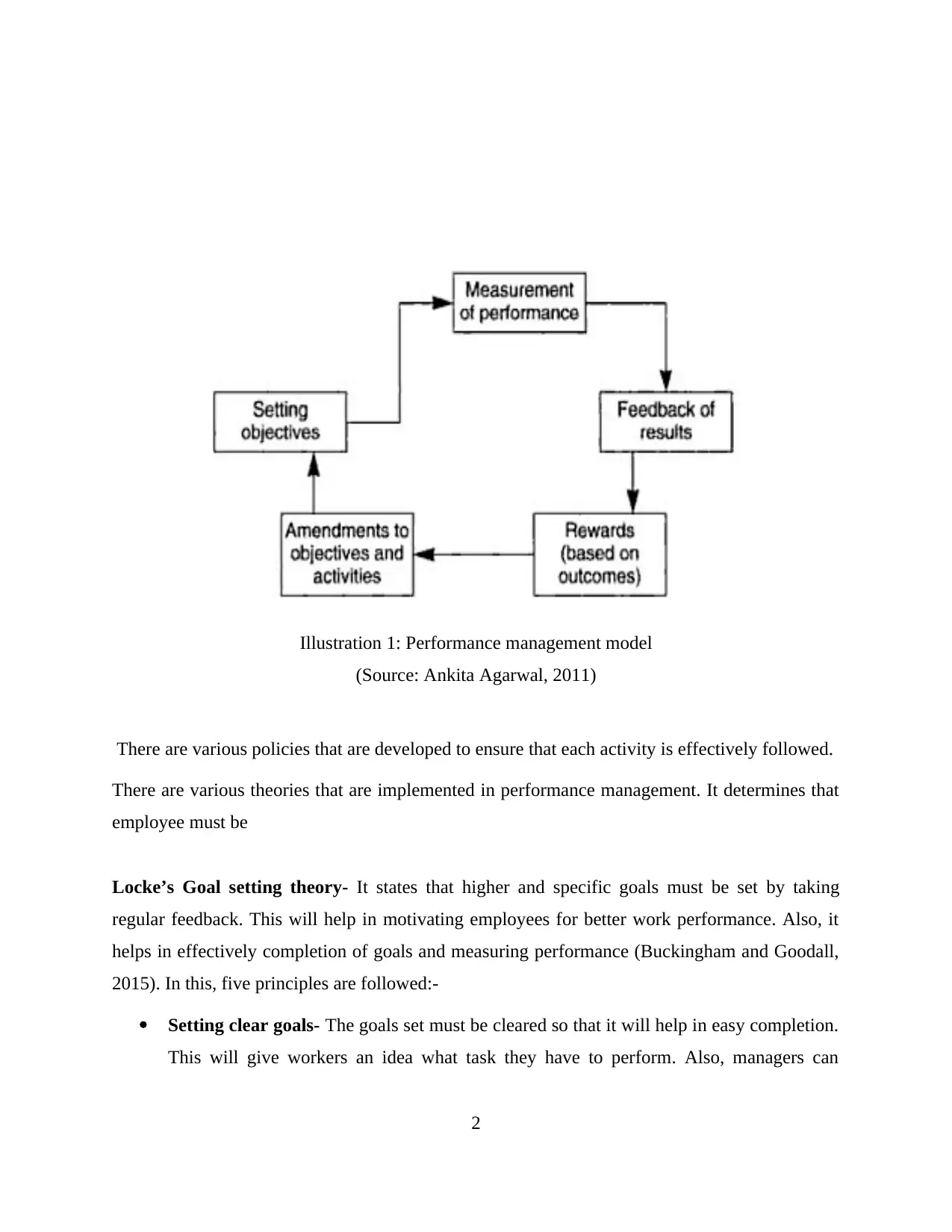
There are various policies that are developed to ensure that each activity is effectively followed.
There are various theories that are implemented in performance management. It determines that
employee must be
Locke’s Goal setting theory- It states that higher and specific goals must be set by taking
regular feedback. This will help in motivating employees for better work performance. Also, it
helps in effectively completion of goals and measuring performance (Buckingham and Goodall,
2015). In this, five principles are followed:-
Setting clear goals- The goals set must be cleared so that it will help in easy completion.
This will give workers an idea what task they have to perform. Also, managers can
2
Illustration 1: Performance management model
(Source: Ankita Agarwal, 2011)
There are various theories that are implemented in performance management. It determines that
employee must be
Locke’s Goal setting theory- It states that higher and specific goals must be set by taking
regular feedback. This will help in motivating employees for better work performance. Also, it
helps in effectively completion of goals and measuring performance (Buckingham and Goodall,
2015). In this, five principles are followed:-
Setting clear goals- The goals set must be cleared so that it will help in easy completion.
This will give workers an idea what task they have to perform. Also, managers can
2
Illustration 1: Performance management model
(Source: Ankita Agarwal, 2011)
Paraphrase This Document
Need a fresh take? Get an instant paraphrase of this document with our AI Paraphraser
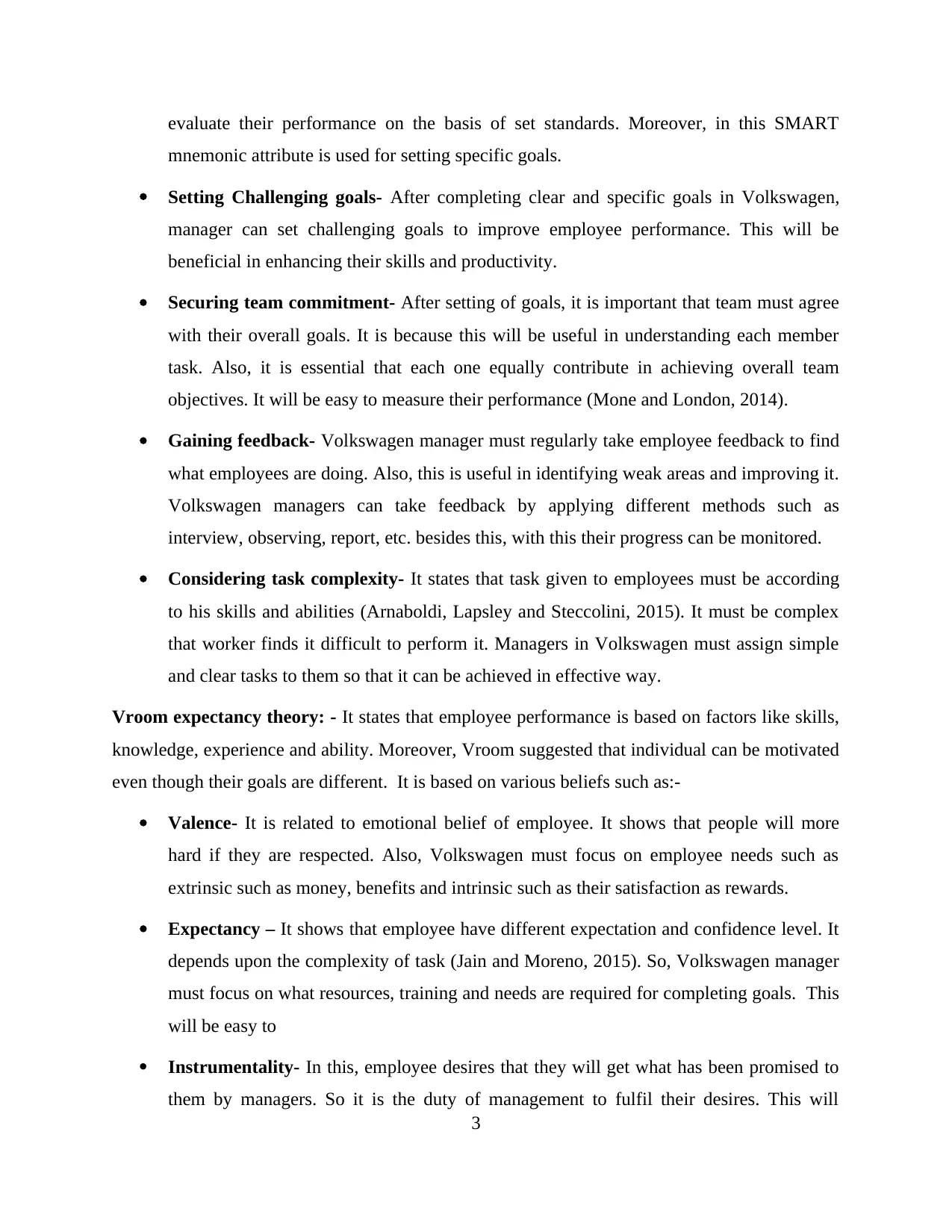
evaluate their performance on the basis of set standards. Moreover, in this SMART
mnemonic attribute is used for setting specific goals.
Setting Challenging goals- After completing clear and specific goals in Volkswagen,
manager can set challenging goals to improve employee performance. This will be
beneficial in enhancing their skills and productivity.
Securing team commitment- After setting of goals, it is important that team must agree
with their overall goals. It is because this will be useful in understanding each member
task. Also, it is essential that each one equally contribute in achieving overall team
objectives. It will be easy to measure their performance (Mone and London, 2014).
Gaining feedback- Volkswagen manager must regularly take employee feedback to find
what employees are doing. Also, this is useful in identifying weak areas and improving it.
Volkswagen managers can take feedback by applying different methods such as
interview, observing, report, etc. besides this, with this their progress can be monitored.
Considering task complexity- It states that task given to employees must be according
to his skills and abilities (Arnaboldi, Lapsley and Steccolini, 2015). It must be complex
that worker finds it difficult to perform it. Managers in Volkswagen must assign simple
and clear tasks to them so that it can be achieved in effective way.
Vroom expectancy theory: - It states that employee performance is based on factors like skills,
knowledge, experience and ability. Moreover, Vroom suggested that individual can be motivated
even though their goals are different. It is based on various beliefs such as:-
Valence- It is related to emotional belief of employee. It shows that people will more
hard if they are respected. Also, Volkswagen must focus on employee needs such as
extrinsic such as money, benefits and intrinsic such as their satisfaction as rewards.
Expectancy – It shows that employee have different expectation and confidence level. It
depends upon the complexity of task (Jain and Moreno, 2015). So, Volkswagen manager
must focus on what resources, training and needs are required for completing goals. This
will be easy to
Instrumentality- In this, employee desires that they will get what has been promised to
them by managers. So it is the duty of management to fulfil their desires. This will
3
mnemonic attribute is used for setting specific goals.
Setting Challenging goals- After completing clear and specific goals in Volkswagen,
manager can set challenging goals to improve employee performance. This will be
beneficial in enhancing their skills and productivity.
Securing team commitment- After setting of goals, it is important that team must agree
with their overall goals. It is because this will be useful in understanding each member
task. Also, it is essential that each one equally contribute in achieving overall team
objectives. It will be easy to measure their performance (Mone and London, 2014).
Gaining feedback- Volkswagen manager must regularly take employee feedback to find
what employees are doing. Also, this is useful in identifying weak areas and improving it.
Volkswagen managers can take feedback by applying different methods such as
interview, observing, report, etc. besides this, with this their progress can be monitored.
Considering task complexity- It states that task given to employees must be according
to his skills and abilities (Arnaboldi, Lapsley and Steccolini, 2015). It must be complex
that worker finds it difficult to perform it. Managers in Volkswagen must assign simple
and clear tasks to them so that it can be achieved in effective way.
Vroom expectancy theory: - It states that employee performance is based on factors like skills,
knowledge, experience and ability. Moreover, Vroom suggested that individual can be motivated
even though their goals are different. It is based on various beliefs such as:-
Valence- It is related to emotional belief of employee. It shows that people will more
hard if they are respected. Also, Volkswagen must focus on employee needs such as
extrinsic such as money, benefits and intrinsic such as their satisfaction as rewards.
Expectancy – It shows that employee have different expectation and confidence level. It
depends upon the complexity of task (Jain and Moreno, 2015). So, Volkswagen manager
must focus on what resources, training and needs are required for completing goals. This
will be easy to
Instrumentality- In this, employee desires that they will get what has been promised to
them by managers. So it is the duty of management to fulfil their desires. This will
3
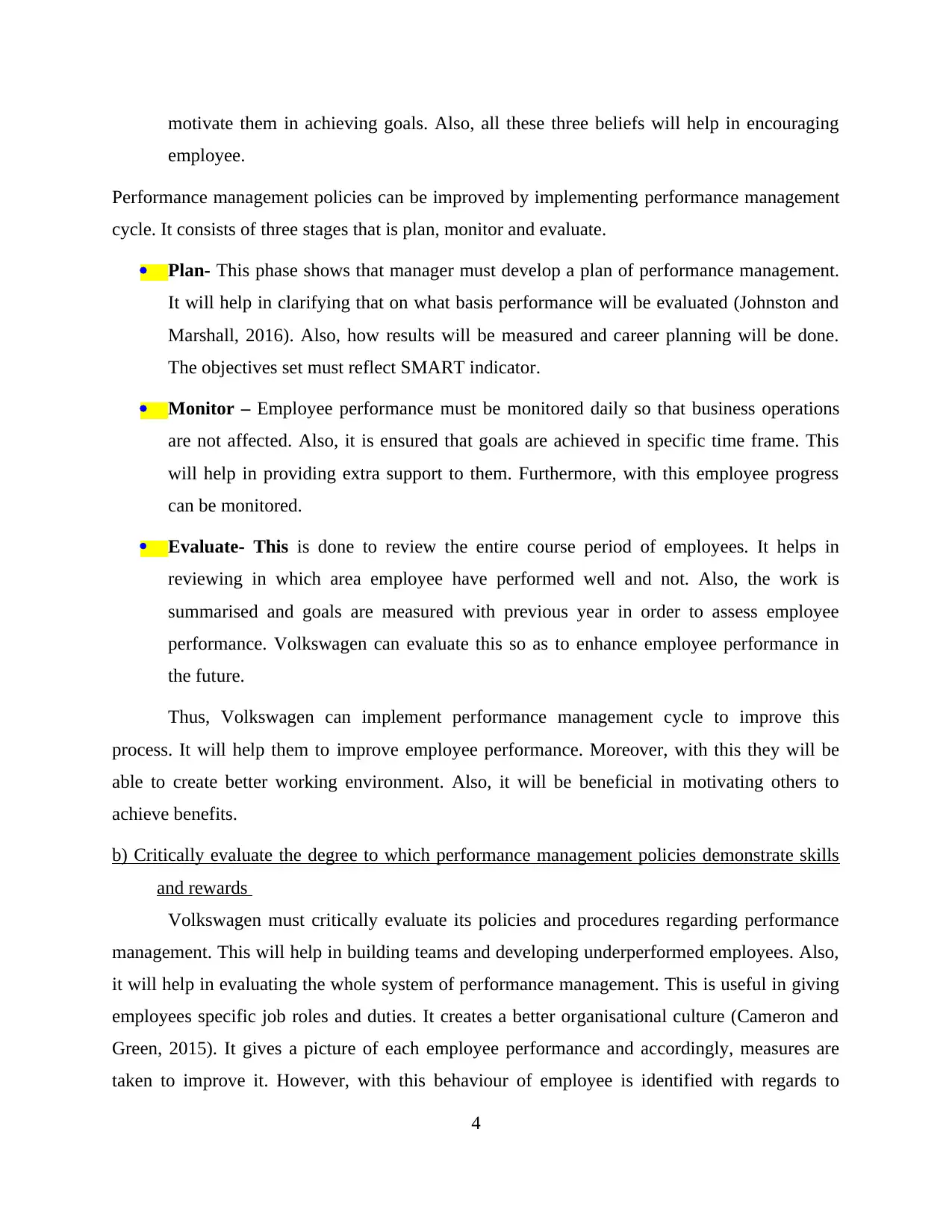
motivate them in achieving goals. Also, all these three beliefs will help in encouraging
employee.
Performance management policies can be improved by implementing performance management
cycle. It consists of three stages that is plan, monitor and evaluate.
Plan- This phase shows that manager must develop a plan of performance management.
It will help in clarifying that on what basis performance will be evaluated (Johnston and
Marshall, 2016). Also, how results will be measured and career planning will be done.
The objectives set must reflect SMART indicator.
Monitor – Employee performance must be monitored daily so that business operations
are not affected. Also, it is ensured that goals are achieved in specific time frame. This
will help in providing extra support to them. Furthermore, with this employee progress
can be monitored.
Evaluate- This is done to review the entire course period of employees. It helps in
reviewing in which area employee have performed well and not. Also, the work is
summarised and goals are measured with previous year in order to assess employee
performance. Volkswagen can evaluate this so as to enhance employee performance in
the future.
Thus, Volkswagen can implement performance management cycle to improve this
process. It will help them to improve employee performance. Moreover, with this they will be
able to create better working environment. Also, it will be beneficial in motivating others to
achieve benefits.
b) Critically evaluate the degree to which performance management policies demonstrate skills
and rewards
Volkswagen must critically evaluate its policies and procedures regarding performance
management. This will help in building teams and developing underperformed employees. Also,
it will help in evaluating the whole system of performance management. This is useful in giving
employees specific job roles and duties. It creates a better organisational culture (Cameron and
Green, 2015). It gives a picture of each employee performance and accordingly, measures are
taken to improve it. However, with this behaviour of employee is identified with regards to
4
employee.
Performance management policies can be improved by implementing performance management
cycle. It consists of three stages that is plan, monitor and evaluate.
Plan- This phase shows that manager must develop a plan of performance management.
It will help in clarifying that on what basis performance will be evaluated (Johnston and
Marshall, 2016). Also, how results will be measured and career planning will be done.
The objectives set must reflect SMART indicator.
Monitor – Employee performance must be monitored daily so that business operations
are not affected. Also, it is ensured that goals are achieved in specific time frame. This
will help in providing extra support to them. Furthermore, with this employee progress
can be monitored.
Evaluate- This is done to review the entire course period of employees. It helps in
reviewing in which area employee have performed well and not. Also, the work is
summarised and goals are measured with previous year in order to assess employee
performance. Volkswagen can evaluate this so as to enhance employee performance in
the future.
Thus, Volkswagen can implement performance management cycle to improve this
process. It will help them to improve employee performance. Moreover, with this they will be
able to create better working environment. Also, it will be beneficial in motivating others to
achieve benefits.
b) Critically evaluate the degree to which performance management policies demonstrate skills
and rewards
Volkswagen must critically evaluate its policies and procedures regarding performance
management. This will help in building teams and developing underperformed employees. Also,
it will help in evaluating the whole system of performance management. This is useful in giving
employees specific job roles and duties. It creates a better organisational culture (Cameron and
Green, 2015). It gives a picture of each employee performance and accordingly, measures are
taken to improve it. However, with this behaviour of employee is identified with regards to
4
⊘ This is a preview!⊘
Do you want full access?
Subscribe today to unlock all pages.

Trusted by 1+ million students worldwide
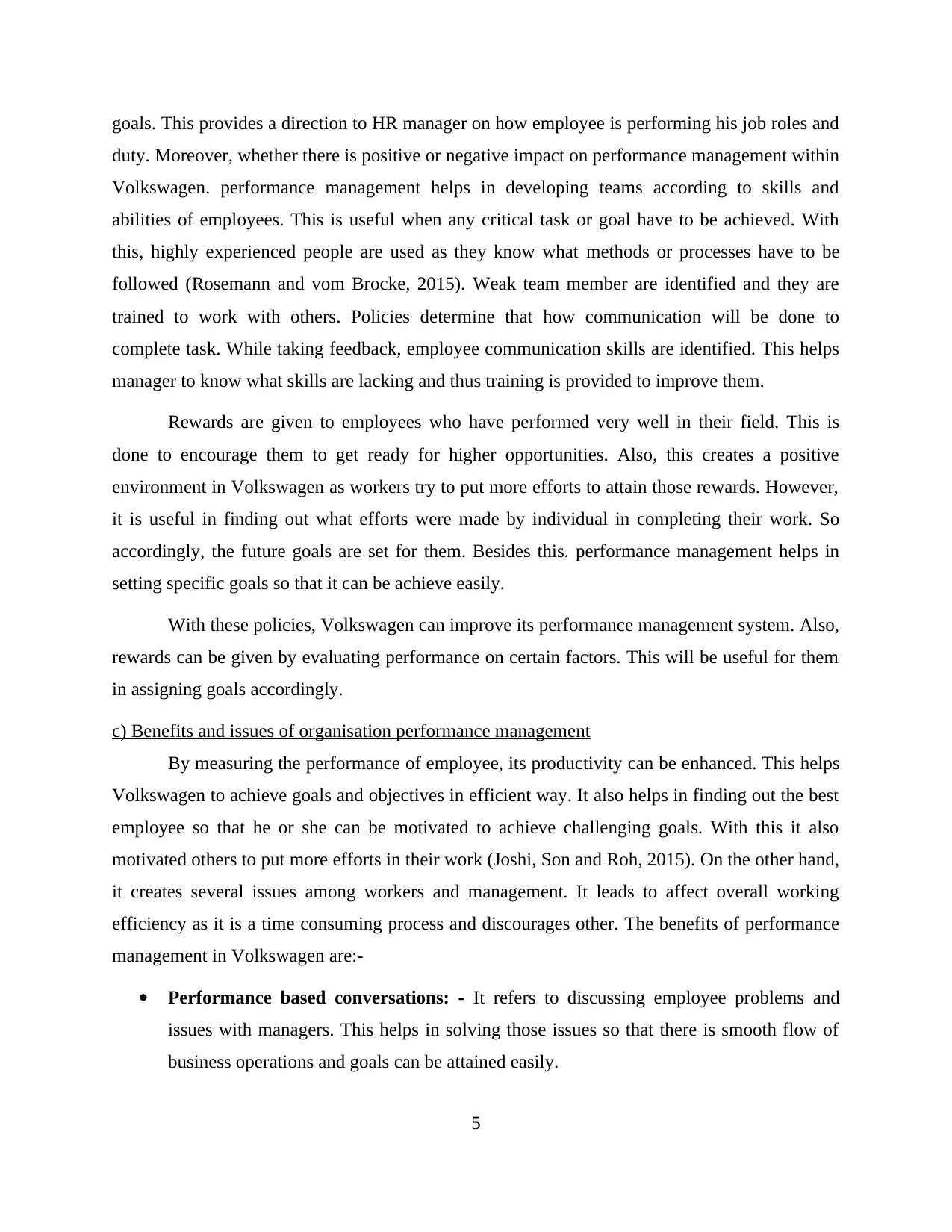
goals. This provides a direction to HR manager on how employee is performing his job roles and
duty. Moreover, whether there is positive or negative impact on performance management within
Volkswagen. performance management helps in developing teams according to skills and
abilities of employees. This is useful when any critical task or goal have to be achieved. With
this, highly experienced people are used as they know what methods or processes have to be
followed (Rosemann and vom Brocke, 2015). Weak team member are identified and they are
trained to work with others. Policies determine that how communication will be done to
complete task. While taking feedback, employee communication skills are identified. This helps
manager to know what skills are lacking and thus training is provided to improve them.
Rewards are given to employees who have performed very well in their field. This is
done to encourage them to get ready for higher opportunities. Also, this creates a positive
environment in Volkswagen as workers try to put more efforts to attain those rewards. However,
it is useful in finding out what efforts were made by individual in completing their work. So
accordingly, the future goals are set for them. Besides this. performance management helps in
setting specific goals so that it can be achieve easily.
With these policies, Volkswagen can improve its performance management system. Also,
rewards can be given by evaluating performance on certain factors. This will be useful for them
in assigning goals accordingly.
c) Benefits and issues of organisation performance management
By measuring the performance of employee, its productivity can be enhanced. This helps
Volkswagen to achieve goals and objectives in efficient way. It also helps in finding out the best
employee so that he or she can be motivated to achieve challenging goals. With this it also
motivated others to put more efforts in their work (Joshi, Son and Roh, 2015). On the other hand,
it creates several issues among workers and management. It leads to affect overall working
efficiency as it is a time consuming process and discourages other. The benefits of performance
management in Volkswagen are:-
Performance based conversations: - It refers to discussing employee problems and
issues with managers. This helps in solving those issues so that there is smooth flow of
business operations and goals can be attained easily.
5
duty. Moreover, whether there is positive or negative impact on performance management within
Volkswagen. performance management helps in developing teams according to skills and
abilities of employees. This is useful when any critical task or goal have to be achieved. With
this, highly experienced people are used as they know what methods or processes have to be
followed (Rosemann and vom Brocke, 2015). Weak team member are identified and they are
trained to work with others. Policies determine that how communication will be done to
complete task. While taking feedback, employee communication skills are identified. This helps
manager to know what skills are lacking and thus training is provided to improve them.
Rewards are given to employees who have performed very well in their field. This is
done to encourage them to get ready for higher opportunities. Also, this creates a positive
environment in Volkswagen as workers try to put more efforts to attain those rewards. However,
it is useful in finding out what efforts were made by individual in completing their work. So
accordingly, the future goals are set for them. Besides this. performance management helps in
setting specific goals so that it can be achieve easily.
With these policies, Volkswagen can improve its performance management system. Also,
rewards can be given by evaluating performance on certain factors. This will be useful for them
in assigning goals accordingly.
c) Benefits and issues of organisation performance management
By measuring the performance of employee, its productivity can be enhanced. This helps
Volkswagen to achieve goals and objectives in efficient way. It also helps in finding out the best
employee so that he or she can be motivated to achieve challenging goals. With this it also
motivated others to put more efforts in their work (Joshi, Son and Roh, 2015). On the other hand,
it creates several issues among workers and management. It leads to affect overall working
efficiency as it is a time consuming process and discourages other. The benefits of performance
management in Volkswagen are:-
Performance based conversations: - It refers to discussing employee problems and
issues with managers. This helps in solving those issues so that there is smooth flow of
business operations and goals can be attained easily.
5
Paraphrase This Document
Need a fresh take? Get an instant paraphrase of this document with our AI Paraphraser
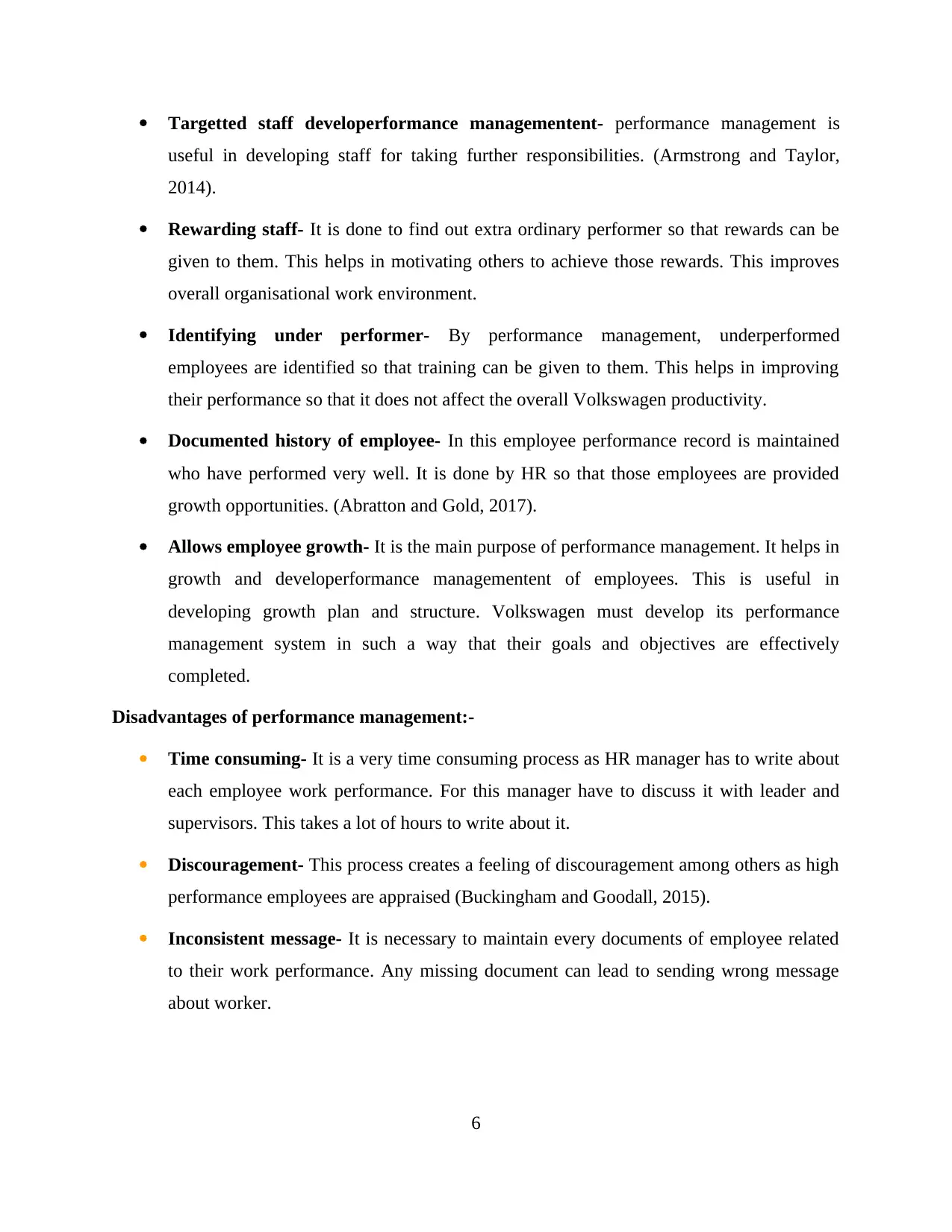
Targetted staff developerformance managementent- performance management is
useful in developing staff for taking further responsibilities. (Armstrong and Taylor,
2014).
Rewarding staff- It is done to find out extra ordinary performer so that rewards can be
given to them. This helps in motivating others to achieve those rewards. This improves
overall organisational work environment.
Identifying under performer- By performance management, underperformed
employees are identified so that training can be given to them. This helps in improving
their performance so that it does not affect the overall Volkswagen productivity.
Documented history of employee- In this employee performance record is maintained
who have performed very well. It is done by HR so that those employees are provided
growth opportunities. (Abratton and Gold, 2017).
Allows employee growth- It is the main purpose of performance management. It helps in
growth and developerformance managementent of employees. This is useful in
developing growth plan and structure. Volkswagen must develop its performance
management system in such a way that their goals and objectives are effectively
completed.
Disadvantages of performance management:-
Time consuming- It is a very time consuming process as HR manager has to write about
each employee work performance. For this manager have to discuss it with leader and
supervisors. This takes a lot of hours to write about it.
Discouragement- This process creates a feeling of discouragement among others as high
performance employees are appraised (Buckingham and Goodall, 2015).
Inconsistent message- It is necessary to maintain every documents of employee related
to their work performance. Any missing document can lead to sending wrong message
about worker.
6
useful in developing staff for taking further responsibilities. (Armstrong and Taylor,
2014).
Rewarding staff- It is done to find out extra ordinary performer so that rewards can be
given to them. This helps in motivating others to achieve those rewards. This improves
overall organisational work environment.
Identifying under performer- By performance management, underperformed
employees are identified so that training can be given to them. This helps in improving
their performance so that it does not affect the overall Volkswagen productivity.
Documented history of employee- In this employee performance record is maintained
who have performed very well. It is done by HR so that those employees are provided
growth opportunities. (Abratton and Gold, 2017).
Allows employee growth- It is the main purpose of performance management. It helps in
growth and developerformance managementent of employees. This is useful in
developing growth plan and structure. Volkswagen must develop its performance
management system in such a way that their goals and objectives are effectively
completed.
Disadvantages of performance management:-
Time consuming- It is a very time consuming process as HR manager has to write about
each employee work performance. For this manager have to discuss it with leader and
supervisors. This takes a lot of hours to write about it.
Discouragement- This process creates a feeling of discouragement among others as high
performance employees are appraised (Buckingham and Goodall, 2015).
Inconsistent message- It is necessary to maintain every documents of employee related
to their work performance. Any missing document can lead to sending wrong message
about worker.
6
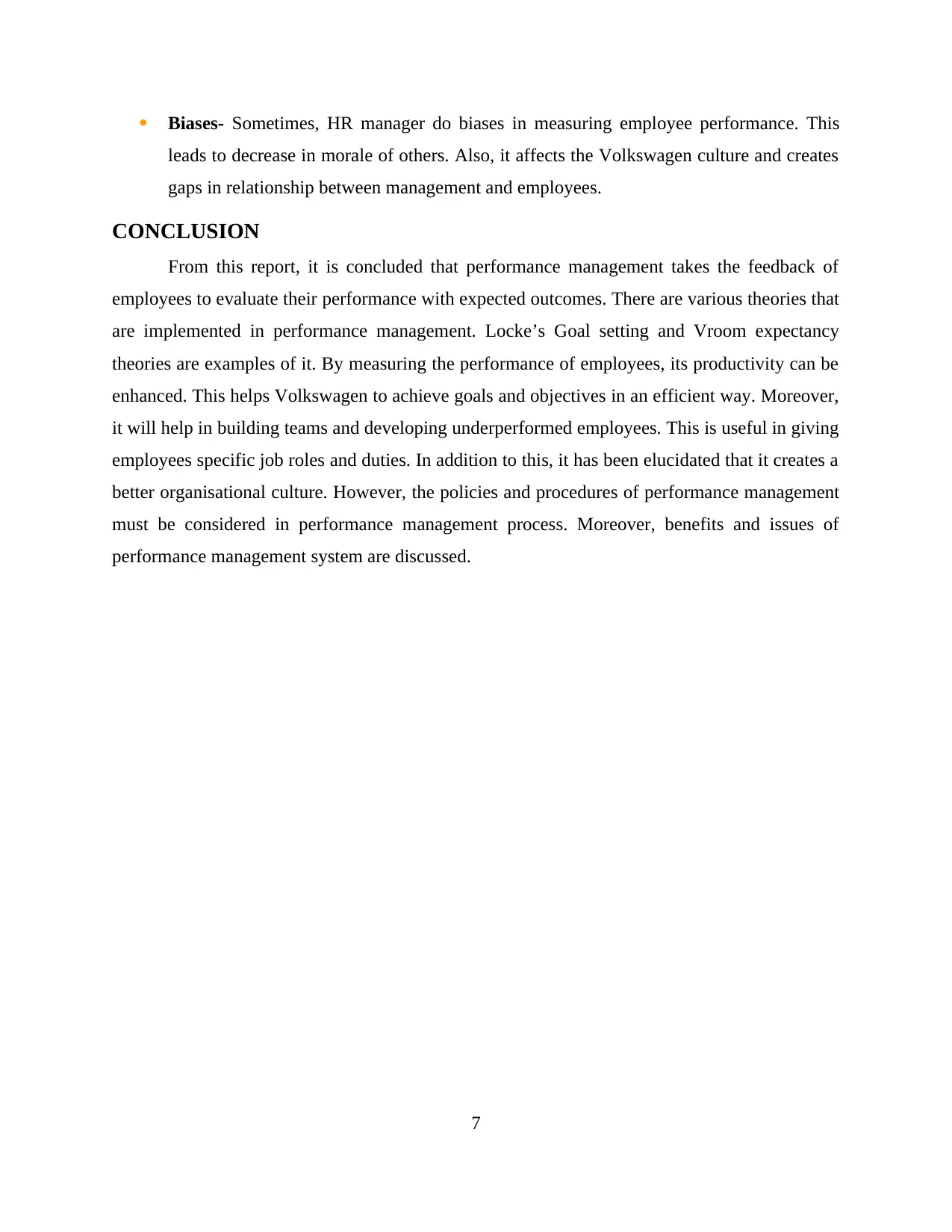
Biases- Sometimes, HR manager do biases in measuring employee performance. This
leads to decrease in morale of others. Also, it affects the Volkswagen culture and creates
gaps in relationship between management and employees.
CONCLUSION
From this report, it is concluded that performance management takes the feedback of
employees to evaluate their performance with expected outcomes. There are various theories that
are implemented in performance management. Locke’s Goal setting and Vroom expectancy
theories are examples of it. By measuring the performance of employees, its productivity can be
enhanced. This helps Volkswagen to achieve goals and objectives in an efficient way. Moreover,
it will help in building teams and developing underperformed employees. This is useful in giving
employees specific job roles and duties. In addition to this, it has been elucidated that it creates a
better organisational culture. However, the policies and procedures of performance management
must be considered in performance management process. Moreover, benefits and issues of
performance management system are discussed.
7
leads to decrease in morale of others. Also, it affects the Volkswagen culture and creates
gaps in relationship between management and employees.
CONCLUSION
From this report, it is concluded that performance management takes the feedback of
employees to evaluate their performance with expected outcomes. There are various theories that
are implemented in performance management. Locke’s Goal setting and Vroom expectancy
theories are examples of it. By measuring the performance of employees, its productivity can be
enhanced. This helps Volkswagen to achieve goals and objectives in an efficient way. Moreover,
it will help in building teams and developing underperformed employees. This is useful in giving
employees specific job roles and duties. In addition to this, it has been elucidated that it creates a
better organisational culture. However, the policies and procedures of performance management
must be considered in performance management process. Moreover, benefits and issues of
performance management system are discussed.
7
⊘ This is a preview!⊘
Do you want full access?
Subscribe today to unlock all pages.

Trusted by 1+ million students worldwide
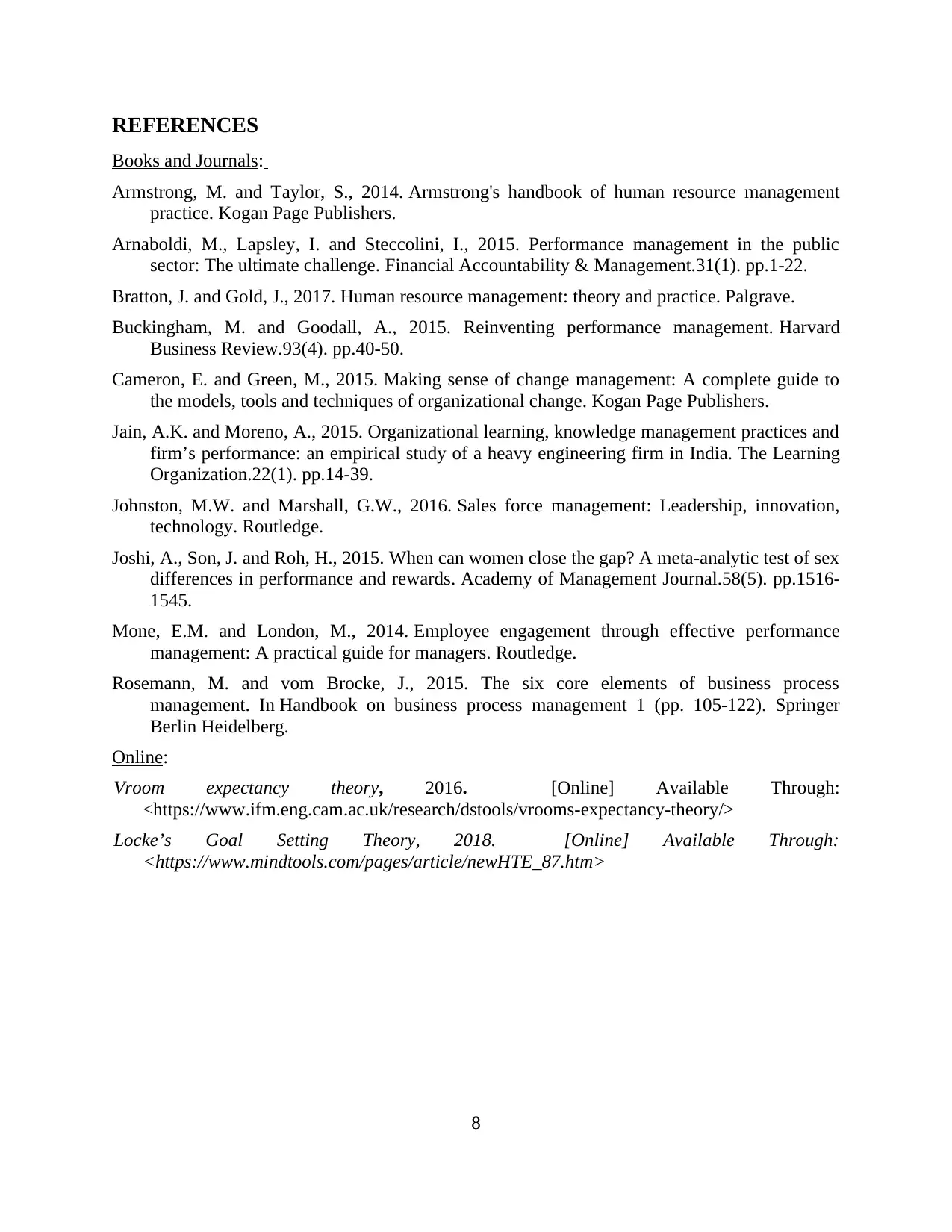
REFERENCES
Books and Journals:
Armstrong, M. and Taylor, S., 2014. Armstrong's handbook of human resource management
practice. Kogan Page Publishers.
Arnaboldi, M., Lapsley, I. and Steccolini, I., 2015. Performance management in the public
sector: The ultimate challenge. Financial Accountability & Management.31(1). pp.1-22.
Bratton, J. and Gold, J., 2017. Human resource management: theory and practice. Palgrave.
Buckingham, M. and Goodall, A., 2015. Reinventing performance management. Harvard
Business Review.93(4). pp.40-50.
Cameron, E. and Green, M., 2015. Making sense of change management: A complete guide to
the models, tools and techniques of organizational change. Kogan Page Publishers.
Jain, A.K. and Moreno, A., 2015. Organizational learning, knowledge management practices and
firm’s performance: an empirical study of a heavy engineering firm in India. The Learning
Organization.22(1). pp.14-39.
Johnston, M.W. and Marshall, G.W., 2016. Sales force management: Leadership, innovation,
technology. Routledge.
Joshi, A., Son, J. and Roh, H., 2015. When can women close the gap? A meta-analytic test of sex
differences in performance and rewards. Academy of Management Journal.58(5). pp.1516-
1545.
Mone, E.M. and London, M., 2014. Employee engagement through effective performance
management: A practical guide for managers. Routledge.
Rosemann, M. and vom Brocke, J., 2015. The six core elements of business process
management. In Handbook on business process management 1 (pp. 105-122). Springer
Berlin Heidelberg.
Online:
Vroom expectancy theory, 2016. [Online] Available Through:
<https://www.ifm.eng.cam.ac.uk/research/dstools/vrooms-expectancy-theory/>
Locke’s Goal Setting Theory, 2018. [Online] Available Through:
<https://www.mindtools.com/pages/article/newHTE_87.htm>
8
Books and Journals:
Armstrong, M. and Taylor, S., 2014. Armstrong's handbook of human resource management
practice. Kogan Page Publishers.
Arnaboldi, M., Lapsley, I. and Steccolini, I., 2015. Performance management in the public
sector: The ultimate challenge. Financial Accountability & Management.31(1). pp.1-22.
Bratton, J. and Gold, J., 2017. Human resource management: theory and practice. Palgrave.
Buckingham, M. and Goodall, A., 2015. Reinventing performance management. Harvard
Business Review.93(4). pp.40-50.
Cameron, E. and Green, M., 2015. Making sense of change management: A complete guide to
the models, tools and techniques of organizational change. Kogan Page Publishers.
Jain, A.K. and Moreno, A., 2015. Organizational learning, knowledge management practices and
firm’s performance: an empirical study of a heavy engineering firm in India. The Learning
Organization.22(1). pp.14-39.
Johnston, M.W. and Marshall, G.W., 2016. Sales force management: Leadership, innovation,
technology. Routledge.
Joshi, A., Son, J. and Roh, H., 2015. When can women close the gap? A meta-analytic test of sex
differences in performance and rewards. Academy of Management Journal.58(5). pp.1516-
1545.
Mone, E.M. and London, M., 2014. Employee engagement through effective performance
management: A practical guide for managers. Routledge.
Rosemann, M. and vom Brocke, J., 2015. The six core elements of business process
management. In Handbook on business process management 1 (pp. 105-122). Springer
Berlin Heidelberg.
Online:
Vroom expectancy theory, 2016. [Online] Available Through:
<https://www.ifm.eng.cam.ac.uk/research/dstools/vrooms-expectancy-theory/>
Locke’s Goal Setting Theory, 2018. [Online] Available Through:
<https://www.mindtools.com/pages/article/newHTE_87.htm>
8
1 out of 10
Related Documents
Your All-in-One AI-Powered Toolkit for Academic Success.
+13062052269
info@desklib.com
Available 24*7 on WhatsApp / Email
![[object Object]](/_next/static/media/star-bottom.7253800d.svg)
Unlock your academic potential
Copyright © 2020–2025 A2Z Services. All Rights Reserved. Developed and managed by ZUCOL.





